|
|
 |
| |
Home > Chapter X
|
|
Chap X. Exploring the future of Rwanda's environment using scenarios
|
Introduction
|
In an increasingly uncertain world, effective environmental stewardship must assume, acknowledge and address the likelihood of future uncertainty. But a host of variables including climate change, uncertain socio-economic and political dispensation, consumer behavior, the national and global economy, demography and culture often obscure a clear road to a sustainable future. Further frustrating is that traditional environmental policy planning methods fail to unmask what could befall our society, environment and economy under competing and interlinked natural resource uses. Seeking more relevant solutions to current and future environmental challenges, the REO has deliberately opted for an outlook approach in order for proactive and innovative policies and strategies to be crafted or explored to ensure the country remains prepared to embrace future volatility - not run from it. This is with the realization that today’s and tomorrow’s challenges can result in multiple outcomes, and that policy formulation and implementation strategies must take them all into account. Environmental scenario planning is a tried and tested method that prepares us for numerous desirable and undesirable outcomes. A number of scenario exercises have been reported in relation to environment and natural resources (Easterling et al. 2007; Odada et al. 2009, Detlef, Ochola & Riha 2008, Sall, & Mureithi 1999, UNEP 2006, UNEP 2007).
In many ways the world in general and Rwanda in particular is vastly different than it was a decade ago and unexpected future changes can have a dramatic impact. Will changing socio-economic conditions threaten or sustain environmental goods and services? Is our country prepared to cope with catastrophic events? What effect could major policy shifts and socio-economic developments have on environment?
Environmental scenario planning helps envision a future very different from the present and develop concrete strategies that ensure success in a number of different plausible futures (Alcamo 2001). It takes a broader and realistic approach that assesses today’s states and trends, explores tomorrow’s eventualities, and prepares us for both. Through scenario planning we are also able to develop specific, measurable indicators that provide an early warning of what the future may bring and the opportunity to start preparing today (Detlef, Ochola & Riha 2008, Easterling et al. 2007, UNEP 2007). The goal of the present Rwandan environmental scenario building process was to present insights into the national outlook, including short-term (up to 2025) scenarios for the major environmental issues addressed in this outlook report and possible policy responses. More specifically, the scenario building process for this outlook report was meant to achieve the following:
- Combine qualitative and quantitative information about the future evolution of environmental challenges and opportunities in Rwanda.
- Help REMA, other stakeholders, policy makers and experts ‘think big’ about various environmental issues;
- Identify the robustness of environmental policies under different future conditions;
- Illustrate how alternative policy pathways can achieve the environmental targets contained in the MDGs and the country’s Vision 2020;
- Provide a picture of future alternative states of the environment in the absence/presence of policies and thus illustrate impacts of society on the country’s natural environment and point out the need for environmental policies to address the impacts;
- Raise awareness about the future connection between different environmental challenges such as climate change and threats to biodiversity and human well-being;
|
The Scenario Building Process
|
To complete this outlook report, REMA in collaboration with other stakeholders with the technical support of UNEP initiated an environmental scenario development process, based on the past models established for the Africa Environment Outlook (UNEP 2006) and the Global Environment Outlook (UNEP 2007) processes. The purpose was to ‘see’ beyond typical assumptions and biases about the future and to promote a ‘longer view.’ The meetings held adopted a participatory scenario building approach to explore the future of the environment and the role of REMA and other stakeholders’ in environmental protection. The teams considered the issues that were assessed in the earlier chapters and how they may be altered into the future through a selected set of interlinked drivers. These are explored in the scenarios presented in this chapter. The scenario building process is reflected in Figure 1.

Developing the scenarios
To frame the scenarios, the Scenario Development Team selected as axes two critical, uncertain driving forces that affect environmental quality and Rwanda's ability to meet its environmental targets in the Vision 2020 (ROR 2000) - economic growth and social cohesion. The economic growth axis was defined in terms of growth or decline in the total production and consumption of goods and services, as measured by the GDP in the national economy and the contribution of various sectors to it. At one end of the economic growth axis is high growth in GDP and growth rate. At the other end of the axis, growth rates slow or become negative.
The social change axis was defined in terms of the extent of shared values, mutual trust, inclusiveness and participation, and willingness to face common challenges and cooperate in meeting them. For purposes of the scenarios, alignment around shared environmental values is one of the main aspects of social cohesion. At one end of the social cohesion axis, most individuals, communities, and organizations are committed to environmental protection. Different actors within society are willing to cooperate with one another and to support government action in order to meet widely recognized environmental challenges. Toward the other end, society is increasingly fractionalized. Many people are indifferent or hostile to environmental values or refuse to recognize the seriousness of environmental challenges. Economic inequities, social conflicts, and practices that exclude people from participation create distrust and limit society's ability to cooperate in meeting challenges. This is shown in Figure 2.

These two ‘drivers’ or axes described as critical uncertainties, intersect to create four quadrants representing four possible scenario worlds: Market Forces, Policy Reform, Fortress World and Great Transitions (UNEP 2006). While they may at times appear exaggerated or unrealistic, each of the worlds represents the plausible extremes defined by the axes. The scenarios are intended to illustrate differing, potential impacts on human vulnerability and the environment presented by these possible worlds. They were constructed for the express purpose of promoting and facilitating strategic discussions among policy makers and environmental custodians.
Scenarios are not predictions. They are stories of how the future might unfold - plausible stories that reflect information about trends and potential future developments. These four scenarios were designed to span a range of potential future conditions. The actual future is not likely to match any one of these four worlds, but it will probably fall somewhere within the range of possibilities that the scenarios explore.
The scenarios
The common aspect of all the explored futures as depicted in the scenario framework in Figure 3 comes down to an attempt to answer the question: how can we achieve sustainable socio-economic development in the most environment-friendly and least costly way possible? In this framework, the projection by policy makers into the suggested four basic scenarios (quadrants) shows different possible mechanisms depicting plausible pathways.
In the Market Forces Scenario, the environmental dimension is hardly perceivable, because it is bound to the effects of scale and product system reorganisation which do not come into the user’s everyday experience. Exploitation of environmental goods and services are dictated by profit objectives and market forces. Solutions to environmental problems are consequently perceived as ‘complete solutions’ in an economic sense: is the offer right for me? If so how much does it cost?
In the Policy Reform Scenario, the environmental dimension is an integral part of the search for sustainable development. Government and institutions attempt to regulate through policies, the impacts of market forces on environment. The responses are however reactive and are barely accompanied by requisite social and behavioural changes.

In the Fortress World Scenario, a few select elite benefit from environmental goods and services at the expense of the vulnerable masses or regions. They, due to security concerns, enclose themselves in enclaves. The majority of the population however lives in degraded ecosystems while the elite institute protective measures to maintain status quo. Environmental conservation is only an integral part of sustainable development among the elite.
Finally, in the Great Transitions Scenario, social regeneration and complete paradigm shift leads to sustainable development and equity. Environmental conservation finds special echo in the theme of sustainable development and social change. Proactive policies and behaviour change characterize natural resources management with popular participation of all stakeholders. The solutions associated with this model are therefore perceived above all as opportunities for integrating social, economic and environmental goals.
The drivers
The drivers summarized in Box 1 are the set of direct and indirect factors that may singly or collectively dictate the future direction of the country’s environment. These will influence the state and trends in environmental resources by dictating the level of production (supply) and consumption (demand) of environmental goods and services.
|
Box 1: Set of drivers for Rwanda Environmental Scenarios and their elements
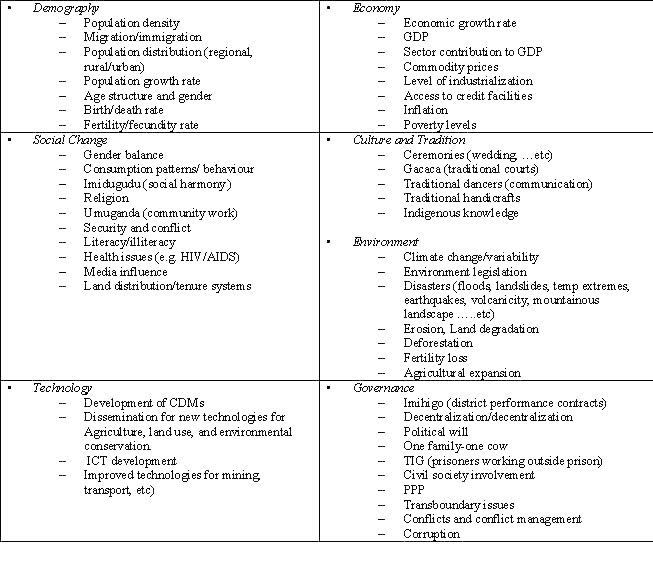
|
|
The drivers are interlinked in ways that may define how the pillars of Rwanda’s Vision 2020 have been crafted and will be achieved. The Vision 2020 identifies six interwoven pillars, including good governance and efficient state, skilled human capital, vibrant private sector, world-class physical infrastructure and modern agriculture and livestock, all geared towards national, regional and global markets in ways that will be directed by these drivers (ROR 2000). The analyses of the environmental issues presented in this outlook are based on qualitative and quantitative assumptions about the trends in each driver by scenario as illustrated in Figure 4.

|
Exploring Rwanda’s Environmental Futures
|
Scenario 1: Market forces
High Economic Growth, Low Social Cohesion & Environmental Irresponsibility
The global economic expansion that began in the new millennium thanks to successive waves of new technology emerging in a context of rapid economic globalization and profit goals was still going strong towards 2025. Profit making, even at the expense of the environment was the critical catalyst. Information technology was finally generating enormous productivity gains, and enabling local and multinational corporations to join in the plunder of Rwanda’s natural resources. Equity and environmental conservation took a back seat in development planning. The creation of regional and global economic blocks and preferential trade partnerships only helped to worsen the social and environmental concerns. The result was an acceleration of economic growth beyond all past experiences with the global consumer culture quickly permeating the Rwandan society, with limited government intervention. Many national companies, as well as ‘multinationals’ that were really loose confederations of national companies, evolved rapidly into integrated transnational corporations. Mergers and takeovers on a global scale created a handful of economic giants that dominated the country’s globalised economy.
Income distribution became more skewed within the country by social class, sector and region. Tensions increased sharply between rich and poor because being rich offered growing benefits such as access to market information and knowledge, social services and power. Population growth and large increases in the use of energy, materials, water, and other resources were having impacts on the environment. But these impacts attracted little attention – or investment – from a society preoccupied with growth and short-term profits. The climate was clearly changing, but Rwanda failed to adjust to these changes easily. The belief, that all the social and environmental stresses arising from population and economic growth could be resolved primarily by widespread ingenuity and the self-correcting action of competitive markets, was predominant.
Specifically, the scenario saw far-reaching health, environmental and social impacts some of which are listed below.
- Rapid urbanization leading to rapid aquifer depletion
- Endangered freshwater ecosystems and fish stocks
- Huge expenses associated with water infrastructure (new and rehabilitated)
- Increased public health risks from lack of access to uncontaminated drinking water and adequate sanitation facilities; food shortages and malnutrition as reduced irrigation limits agricultural production
- Rich people and regions, few corporations, control access to most fresh, quality water
- Water becomes a growing source of division, with access to the best water sources restricted to those who can pay the highest prices; conflicts over water rights in parts of Kigali and other cities and in rural areas
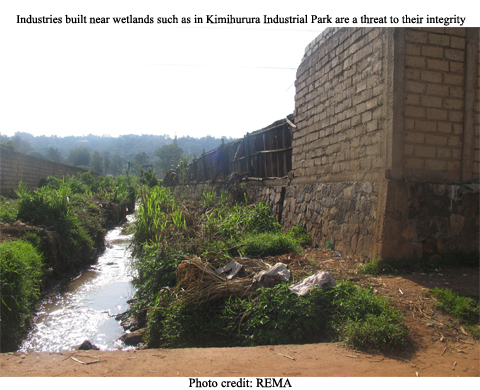
Chemicals
- Rapidly increasing production causes increased chemical loadings in environment
- New chemical compounds are introduced with little concern about their impacts; too many are introduced too fast for adequate testing; unknown effects of interactions between chemicals
- Changes in mortality, growth rates, abundance, and age distributions of plant and animal species; changes in animal behavior patterns and migration
- Impacts of increased chemical production fall primarily on poorer populations
- New pharmaceuticals proliferate; drugs appear in water supply as waste products
Urban sprawl
- Escalating costs for maintaining far-flung low-density infrastructures while under-utilizing existing infrastructure
- Fragmentation of ecosystems, reducing biodiversity
- Increased non-point source pollution; increased air pollution from mobile sources
- Increased storm flow rates and downstream flooding because paved areas impair the landscape's ability to absorb run-off; erosion and water quality degradation
- Increased stress from worsening traffic congestion
- Loss of prime agricultural land
- Loss of wetlands, which are filled or disrupted to accommodate development
- Low income people are concentrated in the cheapest, most deteriorating housing in city slums and old suburbs; isolation from jobs exacerbates unemployment, crime, school breakdown, health and other social problems
- Sprawl continues unabated; the affluent move further out into ex-urban areas, isolate desirable resources like lakes and woodlands in gated communities
- Sprawl, auto-oriented development and high mobility weaken community life and cause a loss of human scale in the built environment
Biotechnology and nanotechnology
- Biotechnology brings developments such as genetically customized medical treatments and foods with higher nutrient value, but most benefits go to the affluent
- Little effort to develop potential of biotechnology or nanotechnology for environmental remediation, clean energy and manufacturing
- Nanotechnology emerges faster than the societal conversation on how to utilize it safely and poses novel risks
- Regulatory processes fail to keep up with rapid introduction of new biotechnology products
- Reliance on a few bioengineered crops leads to extinction of other crop varieties especially traditional crops
- Some biotechnology products cause significant problems such as gene transfer (competitively advantageous traits convey from genetically engineered crops to weeds) and phenotypic surprises (bioengineered organisms exhibit unexpected harmful traits)
- Transnational pharmaceutical firms capture genetic resources of Rwanda, but the country receives no financial benefits
Climate Change
- Rapid growth in energy use and endless debate over the reality and seriousness of climate change leads to a rapid rise in CO2 concentrations
- More intense precipitation events, heavy rainfall days and flooding in some areas; more frequent and severe droughts in other areas
- Increases in accidents and disease associated with extreme weather events
- First measurable shifts of agricultural zones; first losses of wetlands, forests, grasslands due to inability to adapt to rate and magnitude of climate change
- Increases in insect- and animal-borne diseases, both endemic and imported
- First measurable loss of selected fisheries
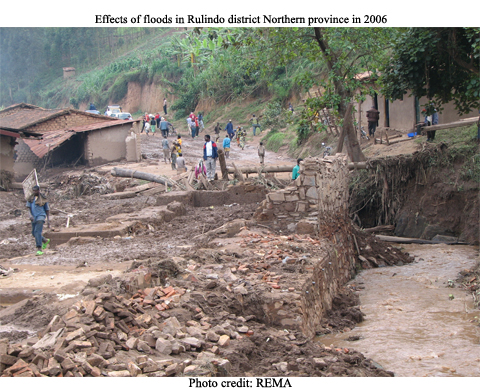
Scenario 2: Policy Reform
Low Economic Growth, High Social Cohesion & Policy Interventions
Global civilization witnessed in the first decades of the 21st century are coupled to judicious measures, regulatory efforts by government to correct the negative impacts of economic growth on environment and society. This continued through 2015 with efforts towards the MDGs and Vision 2020 targets heightened. The efforts were however not enough to bring real change and widespread and equitable prosperity to the people. Government interventions included addressing the demographic structure, environment and other sectors, using new policies, formulation reviews and other instruments. The population was increasing so rapidly many people still struggled to meet basic human needs. Explosive urban growth posed massive challenges of housing construction, infrastructure development, sanitation and public health.
During the 2010s, there was a dawning realization that there was actually a positive side to the economic slowdown witnessed with the country making reforms that were succeeding in attracting investment because of the lower labour costs and ease of setting businesses in Rwanda relative to neighbouring countries. ICT policies also helped the country in the competition for global investments.
There also were environmental benefits associated with this reform-oriented scenario. Exponential growth in resource use and energy consumption had been at the root of worsening environmental problems. Slowing growth eased many environmental impacts. Rising energy prices made it economically practical – indeed necessary – to invest in improving the efficiency of energy and resource use. Funds for investing in efficiency were limited compared to times of faster growth, but the economic pressures to invest in efficiency were unrelenting. The social benefits included strengthening of family and community life as people supported each other in hard times, and enjoyed spending more time together. A religious revival filled churches as religious leaders stressed the value of ‘relationship-based lives’ instead of ‘consumption-based lives’ and called for personal commitments to higher purposes than consumption. A movement emerged in all the country's major religions stressing the unity of country and inter-ethnic cohesion.
Key goals of the reforms in this scenario included national, regional and global cooperation to help populations most in need of assistance, protection of the natural environment, and democratization of emergent local and regional institutions such as the East African Community (EAC). Governments and Internet-enabled social movements cooperated to organize new kinds of environmental monitoring networks and civic accountability networks to monitor industry practices. By 2025, the country had to come to terms with modest economic growth closer to aspirations for a sustainable future. The specific health, environmental and social impacts likely to be associated with this scenario are listed below.
Water
- Access to fresh water is recognized as a basic human right
- Careful communal decisions about water resources are made - how to share water rights, build water infrastructure, investing in appropriate water exploration and management technologies
- People learn to be much more efficient in their use of water
- Huge increases in human and animal waste as population increases
Chemicals
- Chemical production declines; pollution declines, but cleanup also regresses. Big debate over whether the shift leaves the country in better environmental shape than during period of high growth, but little data are generated
- Continued and abundant use of chemicals banned in commerce in developed countries
- Eventual greening of domestic manufacturers serves as a model for the region
Urban Sprawl
- Communities find new kinds of social structures to design ways to live and work that make sense for diverse families and an aging population
- Greater demand for mass transit and affordable modes of ‘clean’ transportation
- Modest housing becomes unaffordable and more, newer but low income neighborhoods are built
- Sprawl abates, people downsize
- Traditional jurisdictional fragmentation gives way to new forms of regional governance that are cheaper to administer and are based on social cohesion
Biotechnology and nanotechnology
- Incidence of inadvertent biotechnology side effects will increase
- Organic agricultural principles and community agriculture replace globalised and high tech agricultural techniques
- Public investment in biotechnology and nanotechnologies is geared toward direct developments to serve the greatest good
- The promise of genetically engineered crops remains unfulfilled, either because of technological difficulties or commercial problems
Climate change
- At domestic level, smaller vehicles, reduced energy consumption and greenhouse gas emissions
- Greenhouse gas emissions continue to rise but have partially abated with lower growth
- Higher altitude ecosystems decline
- Reduced demand for wood products leads to public interest in reforestation in anticipation of an eventual return to high demand with an improving economy
Scenario 3: Fortress World
Low Economic Growth & Low Social Cohesion
By 2025, it's not too hard to see how Rwanda reverted to such a dark period. From the turn of the millennium, irrational exuberant economic optimism prevailed. Despite a few early trouble signals, the policies remained reactive from 2010 with a few people growing richer and richer at the expense of the environment and the poor masses. Energy demand increased unabated. Farm prices rose steadily. Spot food shortages were occurring in unexpected food economic zones of the country. This unfolding food security situation across the different scenarios is shown in figure 5. Effects of the global financial crisis of the first decade of the scenario period lasted longer than expected beyond 2015. Prosperity in Rwanda was not as guaranteed as many thought. Collapse of stock markets globally and protectionist policies set off a chain reaction of negative economic and social events with the old barriers to trade making a comeback as countries circled their wagons in isolationism. Contribution of sectors to Rwandan economy declined. Internationally and domestically the gap between rich and poor was growing. Other social consequences of the Fortress World were considerable after 2015. The poor began to rage at the rich, creating a general atmosphere of blame and intolerance. People's sense of community and environmental protection narrowed greatly to focus only on their own survival within their tribes, clubs, zones, churches or neighbourhoods. Gated communities for those who remained wealthy multiplied. Urban sprawl worsened with the multiplicity of poorly serviced estates in towns. Rural urban migration further exacerbated the situation with crime rates soaring to all time highs between 2020 and 2025. Even noble assistance from the western world for HIV/AIDS was withdrawn exposing the very poor to further suffering.
The environment did not fare too well during these ‘dark days’. Population growth in the poorest parts of the cities and the country led to increased deforestation and soil erosion, escalation of problems that had once been on the verge of being solved. People lost any will to deal with climate change. Many of the alternative and energy efficient technologies that were nearing implementation were delayed or abandoned altogether. By 2015, climate change related disasters became more recognizable and common. Disasters like volcanoes, drought and flash floods increased in frequency with environmental refugees increasing and ability of communities and government to deal with them eroded. Extended droughts affected more areas than the normally prone areas of Bugesera, Umutara, Kigali and Ngali. Flash floods were felt beyond Kigali, Ngali and Byumba. Between 2015 and 2025 hard-won progress towards MDGs and the country’s 2020 Vision on basic environmental improvements as air and water quality was lost. Limited funding was available to repair the dilapidated water infrastructure of the nation's settlements. Specifically the following environmental challenges were experienced.
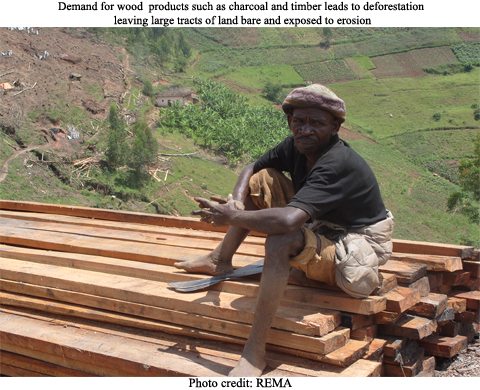
Water
- Absence of economically achievable and innovative technologies for waste treatment and disposal
- Drugs people use appear in water supply as waste products
- Further degradation in water quality due to uncontrolled non-point source pollution
- Huge increases in human and animal waste as population increases
- Waterborne diseases, pathogens increase
- Significant financial needs associated with maintenance and improvements to water infrastructure are ignored
- Water shortages lead to conflict
Chemicals
- The country makes abundant use of chemicals banned in commerce in developed countries
- Increased invasions of alien organisms require use of more pesticides
- Indoor exposures worsen without progress or innovation in materials
- Industry continues to produce a significant number of new chemicals about which little is known
- Unexpected synergistic effects between chemicals occur
Urban Sprawl
- Developments lead to reservoir contamination
- Decent housing becomes unaffordable and more new slums, and less modest neighbourhoods are built
- Localized flooding increases as absorption capacity of landscape decreases
- No comprehensive transportation solutions are developed
- Significant cycle of deterioration in larger cities
Biotechnology and nanotechnology
- Adverse gene flow and ecological effects from existing agricultural biotechnologies are left uncontrolled
- Loss of agro-biodiversity worsens
- Minimal progress made in transforming technologies
Climate change
- Emergent and old diseases and disease vectors advance in previously safe parts of the country
- Greenhouse gas emissions continue to rise, but partially abate with lower growth
- Higher altitude ecosystems start being impacted by climate change with attendant decline in productivity and deteriorating human well being
- No transitions are made to more energy efficient technologies
Scenario 4: Great Transitions
High Economic Growth & High Social Cohesion
By 2025, both the Rwandan and world economies had experienced two back-to-back decades of continuous, vigorous growth. The several crises points experienced along the way about economic stability were turning points changing the character of growth and catalyzing a sweeping shift toward more eco-efficient technologies and sustainable development.
Successive and successful policy responses to address water, land use, climate change, air pollution, urban sprawl and other environmental crises drove home the idea of ‘eco-efficiency’ and collective responsible production and consumption. The popular concept of ‘using advanced technology’ was changed to include the idea of doing more with less by using energy, water and materials more efficiently. Pollution and waste were increasingly viewed as design failures of any development project. During the 2010s, an eco-efficiency design revolution swept through the nation’s economy, affecting agriculture, energy production and use, transportation, manufacturing, and construction. Energy-efficient buildings with healthy indoor environments became the new ideal in architecture and construction. New industrial systems were increasingly designed to work like ecosystems, recycling the ‘wastes’ of each process into ‘food’ for other processes.
All of these technological developments reduced the environmental impacts of growth, but they occurred largely for other reasons. They resulted in better goods and services preferred by consumers. They supported successful businesses and good green jobs. The benefits led to what came to be called ‘the greening of the private sector’ - a growing alignment between private sector, environmentalists and government around shared aspirations for developing superior technologies in every sector.
Environmental protection was increasingly viewed as an integral part of a larger strategy of sustainable development that aimed at improving the economy, protecting and restoring the environment, and achieving greater equity and other social goals - all at the same time. The most important aspect of this strategy was steering research and development into areas of technology that would do the most to reduce environmental impacts per unit of GNP. The strategy also emphasized improved science to deepen understanding of impacts on health and the environment, coordination across agencies and levels of government, partnerships with the private sector, and innovative new approaches to open information access and public dialogue.
Rwanda had increasingly played a strong international and regional leadership role promoting strategies to make a rapid transition to eco-efficient technologies including the use of ICT and cooperation between nations in technology transfer. In this scenario, an abrupt paradigm shift towards more inclusive policies has reversed the negative trend in environmental integrity and natural resource productivity. More specifically agricultural productivity in terms of food and cash crop production has increased due mainly to proactive policies targeting expansion of arable land coupled with adoption of soil fertility management; restoration of degraded landscapes to approach the potential through fertilizer and other input subsidies; enhanced extension and research services for increased use of appropriate agricultural practices and modern inputs; and mitigation against the impacts of adverse climatic shocks.
The overall trends in productivity of food crops have been positive between 2010 and 2020. This has increased beyond the 2020 vision targets toward favorable productivity for key food security crops. The strong impetus from government support has boosted cereals productivity (in particular wheat and rice) and fruits. Even the crops that had earlier stagnated like legumes, bananas and roots and tubers have seen improvements in total area cultivated as well as productivity. Increased production in major export crops was realized between 2015 and 2020 with significant increases seen in black tea by over 25 per cent and a corresponding 30 per cent increase in the value of exports. Privatization of the tea sector which was intensified between 2010 and 2020 was responsible for this upsurge.
In environmental terms, despite the high demographic pressure on land resources agriculture kept pace with environmental conservation spear-headed mainly by land consolidation, reduced human agricultural activities on wetlands and other vulnerable lands. Soil erosion from riverbanks and nutrient loading in water bodies such as the Nyabarongo river system and associated wetlands had been adequately addressed through education and popular participation of land users. There is marked reduction in the proportion of the country’s lands prone to erosion, from the 39.1 per cent in 2009 to less than 10 per cent in 2025.
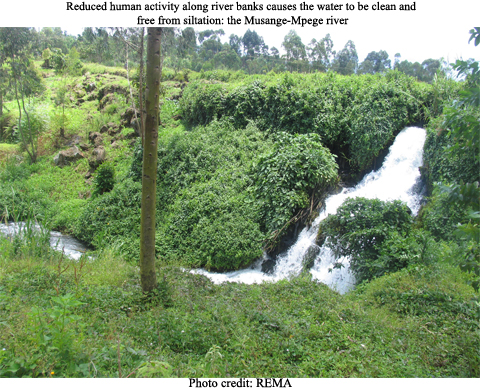
Water
- Water crises in Rwanda and in neighboring countries lead to extensive adoption of water-efficiency technologies
- Water emerges as a catalytic crisis that accelerates efforts to respond to climate change and to shift to new patterns of sustainable development
- Water shortages and domestic tensions and international conflicts lessened
Chemicals
- Chemical production increases, but a shift occurs towards ‘green chemistry’
- Scientific progress makes possible major improvements in understanding the health and environmental impact of chemicals in the environment
Urban Sprawl
- Development of green transportation and manufacturing systems slashes air pollution from mobile sources, but encourages continuation of auto-oriented, low-density development
- Nearly all problems associated with sprawl are checked - from loss of wetlands and fragmentation of ecosystems to escalating infrastructure costs and weakening of community life
Biotechnology and nanotechnology
- Rwanda adopts biotechnology with shifts from ‘for or against’ biotechnology to new concepts of alternative ‘biotechnology development paths,’ some of which are highly problematic while others are promising in terms of health and environmental impacts
- Nanotechnology is still on the horizon, but there is extensive discussion of potential uses for environmental remediation, clean energy, and zero-waste manufacturing
Climate change
- Shift toward higher energy efficiency, fuel cells, renewables, and wellhead reforming of natural gas with CO2 re-injection, begins to reduce CO2 emissions
- Rwanda joins affluent nations in serious efforts to minimize climate change

|
Conclusions :The Interlinkages and Policy Lessons
|
The scenarios explored in this chapter are presented as alternatives which aim to equip us with knowledge to reduce environmental impact and regenerate social environment. It is evident that there lie environmental impacts ahead in every pathway into 2025. More specifically, there are a variety of socio-economic changes that could be required if we are to reduce any environmental impacts and optimize economic gain under each scenario.
The Rwanda Environment Outlook scenarios work distinguishes four possible trajectories into the future: Market Forces - free markets, private enterprise, technological innovation and regional integration that bring growing prosperity and social progress, but with inequities and environmental stress; Policy Reform - reactive institutional and policy reforms enacted, no commensurate social and any particular behavioral changes; Fortress World - conflict between rich and poor, widespread environmental degradation, rising social instability, potential for violence and chaos create a country with islands of prosperity surrounded by an ocean of poverty and despair; and Great Transitions - rising literacy, innovation and technological change, rise of civil society and greening of jobs and corporations lead to dramatically improved human development, environmental productivity, industrial efficiency.
An integrated assessment of these futures and an understanding of the interlinkages between the drivers of environmental change including climate change reveal a road map with challenges and opportunities similar to those highlighted in the country’s Vision 2020 (ROR 2000). Rwanda will have to face these challenges and use the opportunities in realizing the targets set out in Vision 2020. Box 2 illustrates the current state, challenges and possibility of meeting some selected targets of the Vision 2020 and MDGs. More specifically, the country will have to streamline her planning processes to implement these ‘lessons from the future’. All in all, to realize a robust Rwandan society towards 2025 a number of future lessons abound: policy shift towards deepening decentralization; institutional and legislative reforms and capacity building; genuine political will at the highest level of government; robust traditional and formal community institutions; relevant ICT; regional integration; and support from international agencies.
|
Box 2: Rwanda: A futuristic strategic economy developed from a scenario perspective
The main features of Rwanda’s recent socio-economic performance are contained in Republic of Rwanda (2007) and provide a context for elaborating development policy in the medium term. A futuristic view of socio-economic development strategies can be formulated from the fore-running scenario analysis.
Where is Rwanda?
- Economic growth has slowed, population growth continues to be rapid and the environment is under stress.
- Poverty has fallen, but needs to fall faster to meet the MDG and Vision 2020 targets
- Key indicators show that health has improved substantially, but inequalities in health outcomes persist.
- Access to secondary education lags behind primary, but tackling quality aspects of primary education are also a high priority
- Governance reforms are well advanced, but much remains to be done
- Improvements have been seen in a number of important areas:
- Increase economic growth through infrastructure, promotion of skills development and the Services Sector; Private Sector development and modernisation of agriculture.
- Slow down in population growth through reducing infant mortality; family planning and education outreach programmes, quality health care and schooling.
- Tackling extreme poverty through improved food security and targeted schemes of job creation and social protection.
- Efficiency in poverty reduction through better policy implementation, cross-sector coordination; sharper prioritisation of activities; better targeting of services for the poor; widespread mobilisation of the Private Sector; and the more effective use of monitoring and evaluation mechanisms.
Where does Rwanda desire to be?
Goals which reflect where Rwanda wants to be are well captured by the short a, medium and long term targets in the Millennium Development Goals (MDGs) which have targets set for 2015, and the objectives of Rwanda Vision 2020 which have targets set for 2020 as well as the EDPRS with implicit targets for 2012.
Where could Rwanda be?
Given the drivers described in this chapter and the four explicit and mutually exclusive pathways leading to the worlds of Market Forces, Policy Reforms, Fortress World and Great Transitions, the country may or may not achieve its socio-economic development aspirations. Using selected MDG and Vision 2020 targets, the illustration below shows how progress might be achieved under each scenario by 2025.

|
References
|
- Alcamo, J. (2001). Scenarios as tools for international environmental assessment. European Environment Agency, Copenhagen.
- Detlef, P. Vuuren, V., Ochola, W.O. and S. Riha. (2008). Outlook on Global Agricultural Change and its Drivers: Chapter 4 in the International Assessment of Agricultural Science and technology for Development (IAASTD). The World Bank, Washington DC.
- Easterling, W.E., Aggarwal, P.K., Batima, P., Brander, K.M., Erda, L., Howden, S.M., Kirilenko, A., Morton, J., Soussana, J.F., Schmidhuber, J., and F.N. Tubiello (2007). Food, fibre and forest products. Contribution of Working Group II to the Fourth Assessment Report of the Intergovernmental Panel on Climate Change, ed. M.L. Parry, O.F. Canziani, J.P. Palutikof, P.J. van der Linden and C.E. Hanson. Cambridge, U.K.: Cambridge University Press.
- Odada, E.O. Ochola, W.O., Olago. D.O. (2009). Understanding future ecosystems changes in Lake Victoria basin using participatory local scenarios. African Journal of Ecology. 46(s1), 147 – 253.
- ROR (2000). Rwanda Vision 2020. Republic of Rwanda (ROR), Kigali.
- Sall, A. and L. Mureithi, Eds. (1999). Africa 2025: Launching Africa's Long-Term Perspective Study. African Futures. Midrand, South Africa, African Futures.
- UNEP (2006). Africa Environment Outlook 2: Our Wealth Our Future. United Nations Environment Programme (UNEP), Nairobi.
- UNEP (2007). Fourth Global Environment Outlook: Environment for Development. United Nations Environment Programme (UNEP), Nairobi.
|
|
|
|